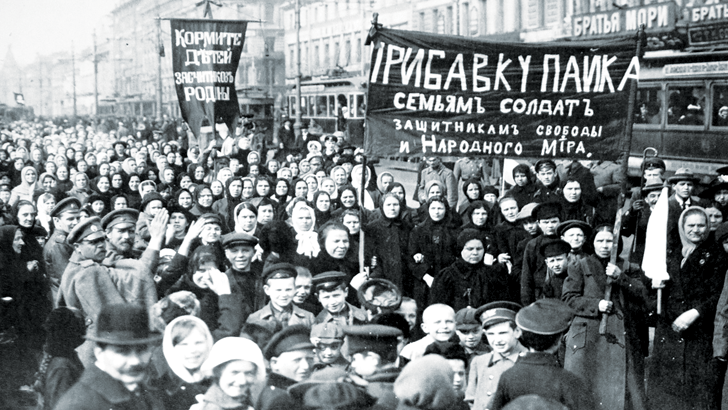Women in the Russian Revolution

The Russian Revolution transformed the lives of women and struck a blow against sexism in a way no event before or after has done.
The advances for women in the months following October 1917 – free abortion on demand, civil marriage, no-fault divorce, guaranteed state support for women with children, the scrapping of illegitimacy laws, equal pay, maternity leave for all women, full decriminalisation of homosexuality, abolition of the age of consent and the pioneering of socially organised and funded kitchen, laundry and childcare facilities – have still not been wholly achieved anywhere in the world more than nine decades later.
But these victories, as groundbreaking as they were, form only part of the story. Equally important in changing the perception and position of women in Russian society was the mass participation of women, alongside men, in revolutionary struggle against the tsarist regime and the bosses who condemned them to unspeakable working conditions and appalling sexist prejudice.
The enormous transformation in attitudes and practices that was the inevitable result of the working class taking democratic control of society confirms Lenin’s contention that revolutions are, at their heart, “festivals of the oppressed”. It was women workers whose actions provided the spark for the revolution in February 1917. Shrugging off the caution of their male comrades, women workers stopped work on International Women’s Day and marched through the streets of Petrograd, demanding that others join them. They called for an end to the war, high prices, hunger and the deprivation workers endured.
One account describes how “they downed tools collectively, left the mills and moved speedily and deliberately in large groups from one factory to another … The women [threw] whatever they could lay their hands on (stones, snowballs, sticks) at factory windows and doors, and [invaded] the buildings.”
Their actions proved to be the catalyst for other workers not only joining them in strike action, but beginning to form their own democratic structures to challenge the regime, the bosses and the war, to which the rich were prepared to sacrifice innumerable workers and impoverish many more. By October, these structures, known as soviets, were able to overthrow the last remnants of capitalist rule and establish a democratic workers’ state.
Because of the war, women made up a considerable proportion of the Russian workforce, up to 40 percent in Petrograd, and their active involvement was therefore crucial to the success of the revolution. As participation in the soviets was voluntary, the extension of respect and equal treatment to all within the movement was paramount to its success.
This led to the questioning of many of the long-standing sexist prejudices that had been taken for granted prior to the revolution. The idea that women naturally belong in the home raising children, or that they should defer to the authority of men, came to be seen as contrary to the interests of workers.
One Bolshevik woman leader observed this effect at a meeting of revolutionary youth. She reported: “One of the items was that all members must learn to sew. Then one young fellow, a Bolshevik, asked: ‘Why should everyone learn to sew? Girls, of course, must be able to sew, otherwise, later on, they will not be able to sew buttons on their husbands’ trousers, but why should we all learn?’
“These words raised a storm of indignation. Not only the girls, but everybody expressed indignation and jumped up and down from their seats. ‛‘The wife must sew buttons on trousers? What do you mean? Do you want to uphold the old slavery of women? The wife is her husband’s comrade, not his servant!’ The lad who proposed that only women learn to sew had to surrender.”
Because the Bolsheviks were the political force most committed to workers taking power in 1917, they were also the organisation that devoted the greatest effort to organising women workers. They organised among laundresses and soldiers’ wives, two of the most downtrodden groups of women, and produced pamphlets and other literature addressing the specific conditions of women workers. The Bolsheviks recognised the link between the fate of workers’ power and women’s liberation.
In October, women took part in the insurrection, joined the Red Guard and took part in the storming of the Winter Palace. A young Bolshevik tramway worker, Aleksandra Rodionova, was given responsibility for coordinating the trams in Petrograd during the insurrection. She described the profound impact the revolution had on her and others: “I felt that all of my familiar life was falling apart, and I rejoiced in its destruction.”
Ultimately, the gains of the revolution were destroyed. Stalin’s counter-revolution erased all vestiges of workers’ power, and with them the gains made for women. But this in no way negates the achievements of the revolutionary workers in 1917, nor the insight they provide us with as to the potential of workers’ revolutions to challenge all forms of social injustice.
The role of the mass of workers, especially of women workers, tends to be sidelined or ignored by most mainstream accounts of the revolution. The intention of these historians is usually to discredit radical politics and mass action, and to engender resignation to the status quo. But the events of 1917 prove there is an alternative to capitalism.
They demonstrate the way the oppressed come to the forefront and help shape society in revolutionary struggle, how sexist prejudices can begin to be challenged on a mass scale and how the working class can strike at the heart of all forms of oppression and inequality. Understanding this process is essential to all those committed to women’s liberation.
[To learn more, come to the session “Debates about women in the Russian revolution” (Saturday 4pm) – part of the Gender and Sexuality series at Marxism 2014: marxismconference.org.]